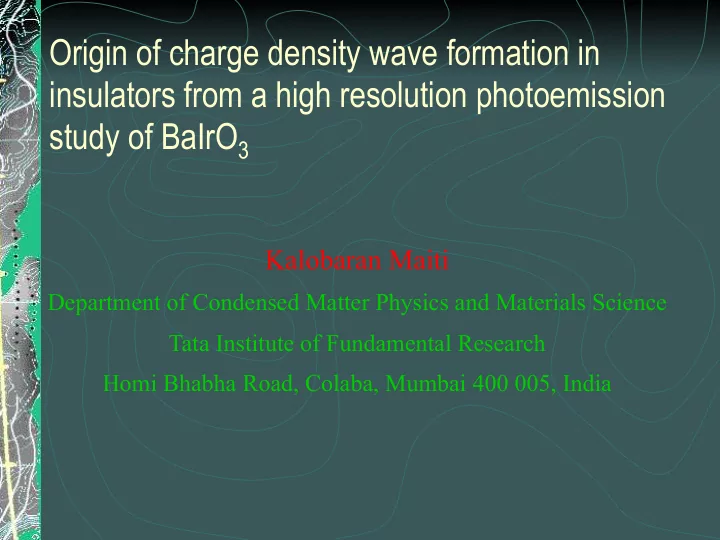

Origin of charge density wave formation in insulators from a high resolution photoemission study of BaIrO 3 Kalobaran Maiti Department of Condensed Matter Physics and Materials Science Tata Institute of Fundamental Research Homi Bhabha Road, Colaba, Mumbai 400 005, India
Correlation in 3d oxides
d -band in transition metal oxides A. Fujimori et al . PRL 69, 1796 (1992).
DMFT results U/D = 1 U/D = 2 U/D = 2.5 U/D = 3 U/D = 4 A. Georges et al. Rev. Mod. Phys. 68, 13 (1996).
DOS Incoherent feature He I spectra Intensity (arb. Units) Coherent feature Ca 1- x Sr x VO 3 Energy (eV) I.H. Inoue et al . PRL 74 , 2539 (1995) M.J. Rozenberg et al. PRL 76 , 4781 (1996) A. Georges et al. Rev. Mod. Phys . 68 13 (1996)
CaVO 3 SrVO 3 Paramagnetic metal Paramagnetic metal V 4+ à 3 d 1 V 4+ à 3 d 1 z y x a = 5.318 Å ; / V-O-V = 154.3 o a ~ 5.43 Å b = 5.343 Å (in xy -plane) / V-O-V = 180 o c = 7.543 Å ; / V-O-V = 171 o
All the spectra are dominated by the incoherent feature intensity à energy scale ~ eV Experimental specific heats are close to the LDA values à Energy scale ~ meV CaVO 3 SrVO 3 mJ/(mole.K 2 ) mJ/(mole.K 2 ) LDA 4.85 4.13 Experimental 7.3 6.4 Estimated values from photoemission ~ 10 times higher than the experimental values PHYSICS AT HIGH AND LOW SCALES MAY BE DIFFERENT
Spectra exhibit strong dependence on the surface sensitivity of the technique. Sr 0.7 Ca 0.3 VO 3
CaVO 3 SrVO 3
Fit the surface and bulk spectra within Hubbard model using dynamical mean field theory (DMFT). The DMFT equations are solved using iterated perturbation theory (IPT). v Surface spectral function, ρ s ( ε ): U/W = 1.5 for SrVO 3 = 2.0 for CaVO 3 v Bulk spectral function, ρ b ( ε ): U/W = 0.67 for SrVO 3 = 0.83 for CaVO 3
CaVO 3 SrVO 3 mJ/(mole.K 2 ) mJ/(mole.K 2 ) LDA 4.85 4.13 Experimental 7.3 6.4 DMFT 5.5 3.7 The above results are obtained for the case of a non-degenerate half filled band. Small underestimation of the specific heat parameters may be related to the neglect of the d -band degeneracy.
Correlation in 4d oxides
� � � 3d 4d 4 d orbitals in 4 d TMO are more extended that 3 d orbitals in 3 d TMO. Expectations: Correlation effects à less important Ab initio approaches à more � successful.
CaRuO 3 SrRuO 3 Paramagnetic / anti-ferromagnetic / Ferromagnetic metal Ru 4+ à 4 d 4 spin-glass metal Ru 4+ à 4 d 4 y Ru z x a = 5.574 Å; Ru-O1-Ru = 167.6 o a = 5.519 Å; Ru-O-Ru = 150 o b = 7.852 Å (in xy -plane) b = 7.665 Å c = 5.538 Å ; Ru-O2-Ru = 159.7 o c = 5.364 Å
Incoherent feature Coherent feature Dominant incoherent feature à U/W large t 2g peak appears between 0 – 1 eV XPS spectra: Lineshape in XPS is different Dominant peak at ~ 0.6 eV Surface might have different electronic structure
Conclusion from 3d and 4d systems Surface and bulk electronic structure in transition metal oxides can be significantly different Electron correlation strength reduces significantly while going down the series
5d oxides Expected behavior Correlation effect is significantly weak Ab initio approaches may be applicable Electron-lattice interaction will increase
Structure BaIrO 3 : Monoclinic Orthorhombic
Structure
Current-voltage Non-linear Anisotropy G. Cao et al . Solid State Commun. 113 , 657 (2000)
Resistivity (single crystals) Resistivity is highly anisotropic à Quasi-one-dimensional structure Insulator to insulator transition at 175 K vs 1/T à λ - type peak Insulator to metal transition at 80 K and metal to insulator transition at 26K Ferromagnetic transition at 175 K G. Cao et al . Solid State Commun. 113 , 657 (2000)
Periodic lattice a CDW 2a Half filled band Metal CDW Insulator
BaIrO 3 Insulator and exhibit Charge Density Wave transition at 175 K It also exhibit ferromagnetic transition at the same temperature
Specific heat (polycrystals) Polycrystals seem to be better than single crystals Anomaly is stronger ( Δ C = 2J/molK) compared to single single crystal data ( Δ C = 0.7 J/moleK) N.S. Kini et al. Physica B (2005)
Resistivity (polycrystals) d ( ln ρ ’ ) / d ( 1/T ) 185 K Polycrystals 250 K seem to be better than 111 K single crystals Higher resistivity than single crystal data 185 K Transition temperature is higher
Valence band
Band structure results
Ir 5 d Surface appears to be similar to the bulk bandwidth is similar to the calculated results There is some spectral redistribution !!
Temperature dependence
At high energy resolution, the intensity close to the Fermi level can be expressed as g ( ε ) à Spectral DOS
Pseudo gap
Elector-magnon coupling !!
Ba 3d Core levels are shifted across 250K and no effect below 250 K
Ba Core levels are shifted across 250K and no Ba 4d effect below 250 K BUT not Ir core levels
78% Signature of A multiple different Ba sites 22% B A,B,C,D are 25K spectra 78% C 22% D
Conclusions The evolution of charge density wave due to localized electronic states directly demonstrated. We observe opening of a soft gap across the CDW transition. The spectral density of states reveals the role of magnetism on the electronic structure. à an intimate relationship between ferromagnetism and charge density wave in this system. The profound changes in the Ba-O covalency prior to the formation of charge density wave poses a new question with respect to the role of precursor effects.
Collaborators: Ravi Shankar Singh, V.R.R. Medicherla, S. Rayaprol, E.V. Sampathkumaran D.D. Sarma I.H. Inoue M.J. Rozenberg
Thank you
Recommend
More recommend